 70+ submarine conversions 1947-1959
70+ submarine conversions 1947-1959Guppy I, IA, IB, II, IIA, III, Fleet Snorkel
Cold War US Subs
GUPPY | Barracuda class | Tang class | USS Darter | T1 class | X1 class | USS Albacore | Barbel classUSS Nautilus | USS Seawolf | Migraine class | Sailfish class | Triton class | Skate class | USS Tullibee | Skipjack class | Permit class | Sturgeon class | Los Angeles class | Seawolf class | Virginia class
Fleet Snorkel SSGs | Grayback class | USS Halibut | Georges Washington class | Ethan Allen class | Lafayette class | James Madison class | Benjamin Franklin class | Ohio class | Colombia class
The ‘Fleet Snorkels’ to the rescue
Although the conventional submarine fleet of the USA was impressive in 1960, most models has been experimental or delivered in short series. The bulk of the active units was still the large, roomy, and battered Gato/Tench/Balao serie of WW2. This represented a force of 77 units, of which 20 were lost. This represented a total of 57 boats available for possible upgrades. Eventually all this fleet was upgraded, and some of them went through two waves of modernization or were exported to NATO countries during the cold war.
Their main advantage was their large size, but they were obsolete compared to the Type XXI and versus the new “Whiskey” class attack submarines mass-produced by Stalin in the 1950s. So a large modernization program was launched in the 1950s, which ended with the conversion of these boats under various standard, called GUPPY I, Ia, II, IIa and III. In the end, Guppy boats would serve for most of the cold war under many flags, some even until the 2000s, and one was even sunk in a military action (ARA Santa Fe).
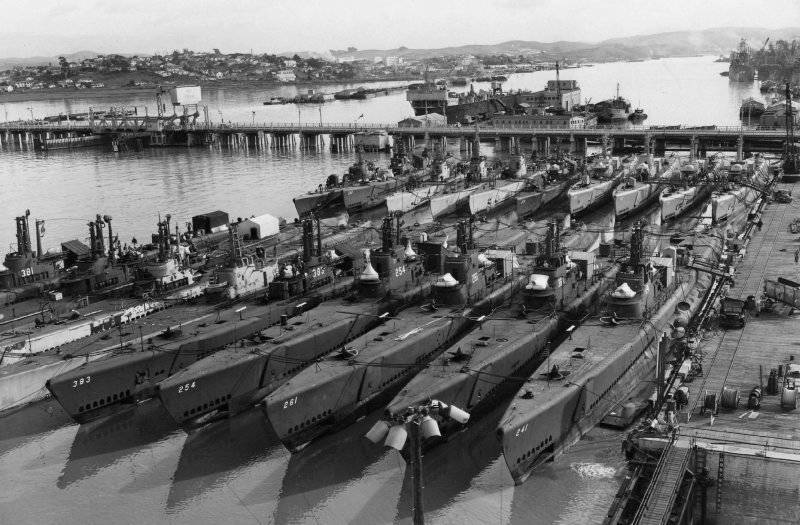
Development of the Greater Underwater Propulsion Program
The Navy after 1945 was perfectly aware that its WW2 sub fleet was no longer relevant with the latest underwater propulsion technology pioneered by German engineers with the type XXI and XXIII. The first was obtained as war prize by the Soviet Union so it was clear that it would not be long before a new submarine would be developed over this design. The admiralty wanted to improve the submerged speed, the manoeuvrability and the endurance of the whole submarine force, while at the same time, new programs would lead to the design of a brand new generation.
The first prototypes of these would be the Barracuda (SST3) class, and the larger Tang class. The Greater Underwater Propulsion Power Program was quickstarted alongside, and will feed US cold war submarine design back and forth along its iterations. A catchy name was needed to attract and hold attention and “GUPPP” was not desirable. A ‘P’ was dropped and a ‘Y’ added, coining ‘GUPPY’ which sounded better and almost like a fish name. The program was nevertheless secret for most of the cold war, and what we now know about it was recently declassified.
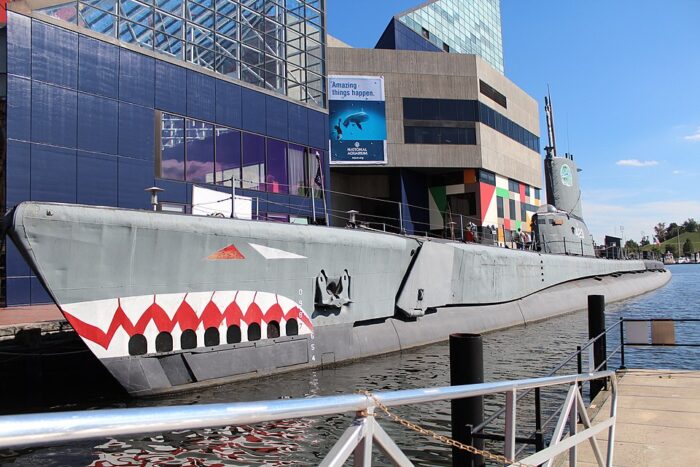
USS Torsk as preserved today.
The GUPPP program started in 1945 already, as the US Navy obtained two German Type XXI boats as war reparation. The U-2513 and U-3008 were extensively studied and tested, and lessons learned, like the large battery capacity, streamlined structure and hull, a snorkel, and better fire control system. This led to a USN design which over the years 1946-49 became the Tang class, which made all previous USN submersibles obsoletes. In fact it was the very first USN “Submarine” with the Barracuda class. But it was also quite expensive and in these times of military budget cuts, the Navy preferred to upgrade the existing fleet boats to the Tang’s standards rather to built a brand new fleet of submarines. Indeed in 1945, most of these Gato/Tech and Balao series were just a few years old, far too short for a retirement.
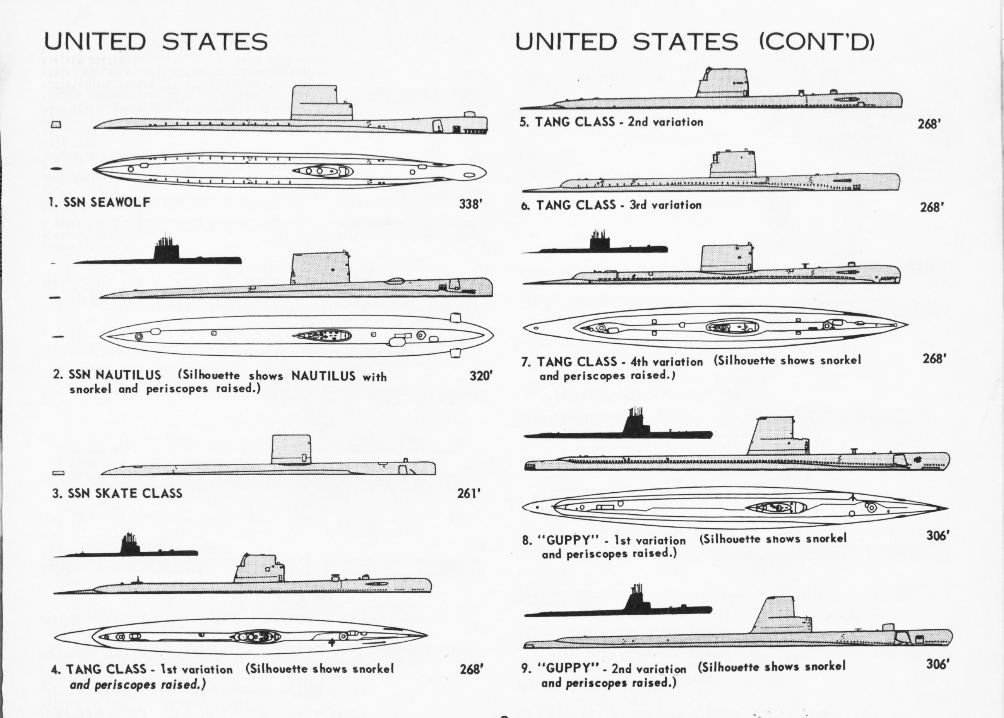
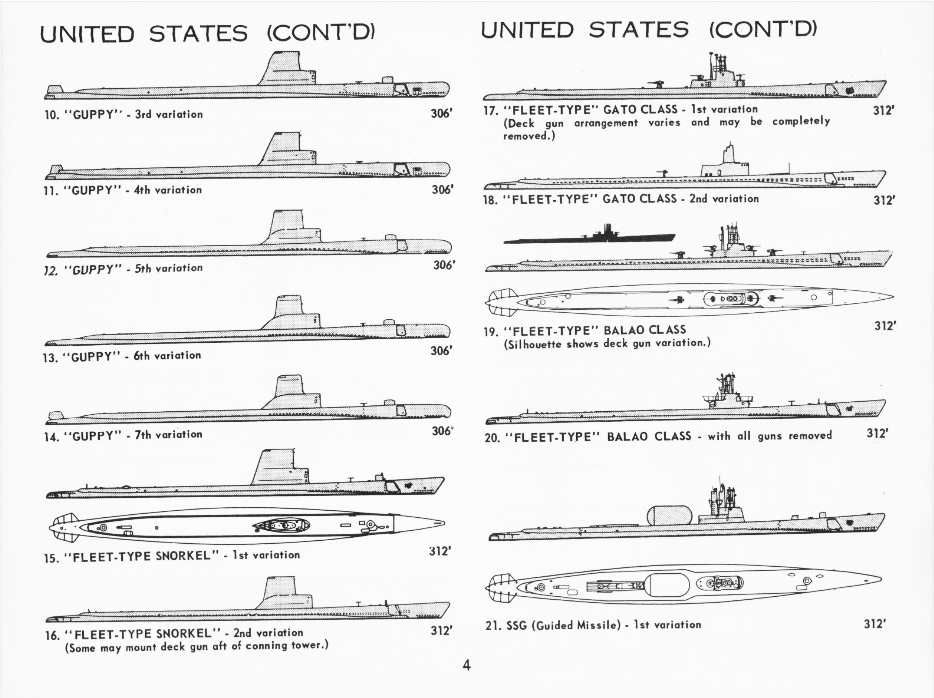
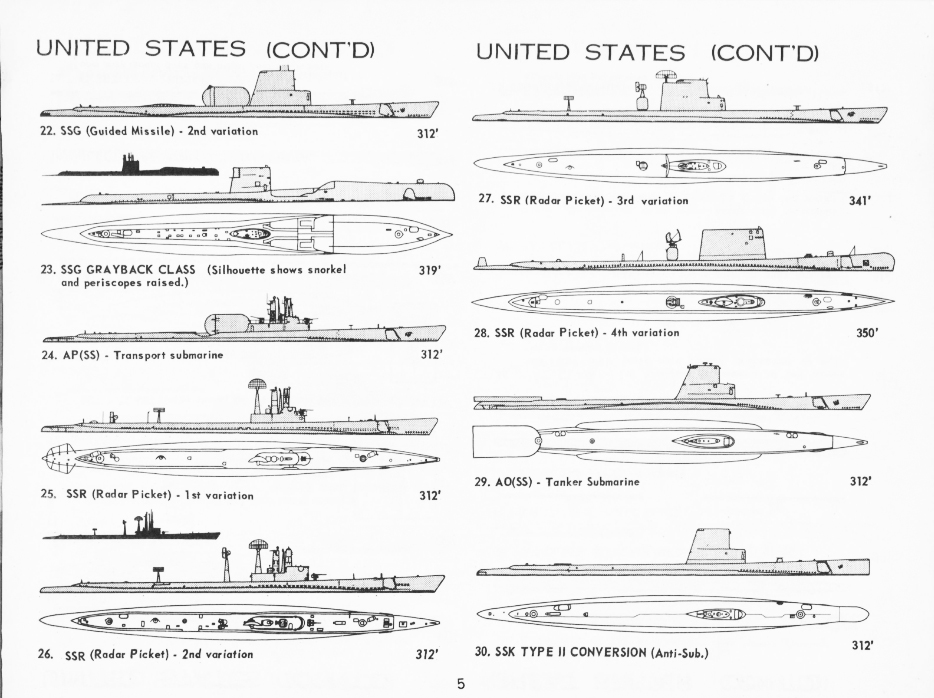
ONI-plates submarines
The navy was a bit at odds with the the Bureau of Ships, which believed the existing Gato, Balao, and Tench fleet could be modified at lower cost rather than the Navy which wanted large series to replace them, but a compromise was found and by June 1946, the Chief of Naval Operations approved the GUPPY project. The Navy agreed to produced only limited numbers of the new boats, gradually implementing new innovations along the way. This explains also the large diversity of submarines types and conversions in the US Fleet of the 1950-60, basically the pre-nuclear era.
The initial two-boat test program started at the Portsmouth Naval Shipyard. Upgrades would go on through seven incrementations, namely and in order, the GUPPY I, GUPPY II, GUPPY IA, Fleet Snorkel, GUPPY IIA, GUPPY IB, and GUPPY III modernization. Some boats indeed went through one phase and another later. Ship Characteristics Board/SCB project number were given each time and therefore their identification prefix changed along the years. It should be noted that the Royal Navy embarked in a similar program, modernizing 24 wartime and post-war British T/A-class models. Streamlined hulls, sail-type conning towers, and better underwater performance were all implemented in 1948-60, and France also launched similar experiments.
Guppy I (1946)

Author’s rendition of the GUPPY-I, USS Pomodon (SS 486)
The prototypes for this whole GUPPY improvements were USS Odax and USS Pomodon, both Portsmouth-built Tench class boats. The main reason was they were recent, completed 11 July and 11 September 1945 and in pristine conditions. They were sent into drydock for the very first conversion, Pomodon from 25 October 1946 to 26 July 1947 and Odax September 1946-August 1947. They would be converted again in 1955 to a higher GUPPY level.
External changes:
These GUPPY I boats featured a brand new streamlined bridge and shears structures. New periscope and radar mast supports were also devised, and they ended as much taller. The fin was built basically with a distinctive step, starting in recess after the conning tower forward section. To further reduce hydrodynamic drag, one periscope was deleted. An SV radar aerial was also added to the top of the sail. No snorkel was fitted yet as this technology was still in development at that type, and moreover adaptation was proven more difficult than expected. The Deck gun and associated containers of course was removed, as well as the hull’s ballast filler openings. Instead, newly design ones were fitted over the main ballast bulge. The rest of the hull was basically the same. Capstans, cleats, and rail stanchion supports were redesigned to be retracted or removed, for better streamlinng and the classic clipper bow “fleet boat bow” replaced by the trademark rounded “Guppy bow”, showed to give better performances underwater.This new bow also housed sonar hydrophones in a “chin mount”. From then on, the new the faired structure around the conning tower and mast supports became the “sail”.
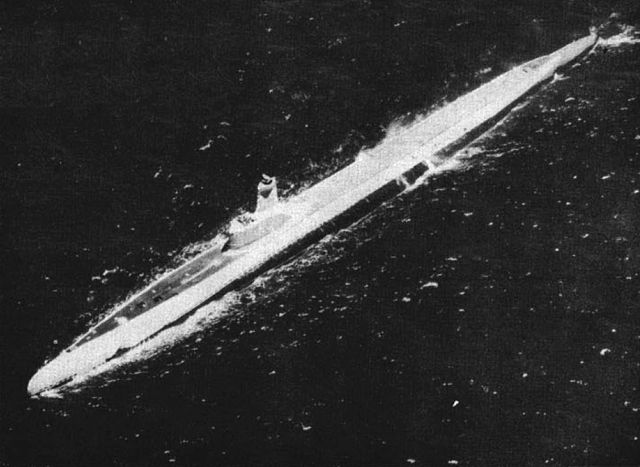
USS Pomodon (SS-486), a GUPPY-I circa 1948
Internal Changes:
There was a complete rearrangement of the inner tube to accommodate larger battery wells, and fit much larger and batteries. The goal was to at least double the electrical power. These batteries were also brand new. They used many more and thinner plates, generating higher current, and for a longer time. but they also had a shorter life calculated at 18 months. Previous ones could last for five years but took also longer to charge. Former batteries also needed specific ventilation to remove hydrogen gas and cooling water, notably to cool down termination bars. These new four 126-cell batteries (in total 504 cells), which required a larger space, taking basically the former storage, ammunition, and refrigeration spaces on board. They were connected either in series or parallel to prove a variety of voltage and current intensity, modulated into various speeds. They were placed in the following fashion: Two in the after battery well, one-and-a-half at the lower level, forward battery well, and remaining half, forward end of the pump room.
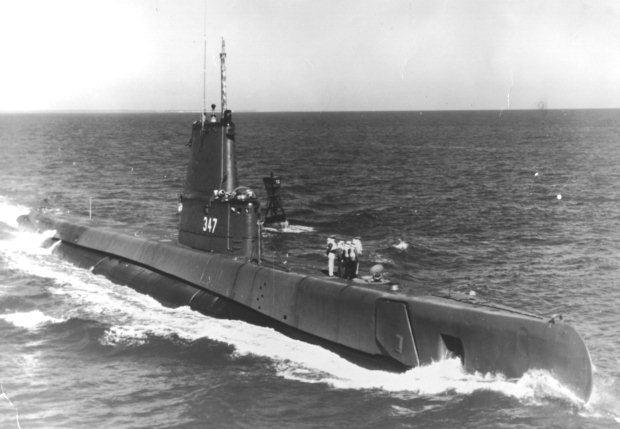
USS Cubera, Guppy-I conversion
The main engine room saw its 1930s high-speed motors and reduction gears replaced by slow-speed motors, connected to the batteries. Also, open-front switchboards gave way to enclosed splash-proof cabinets and electrical loads passed onto the 120 volt 60 hertz standard. Ship electronics on their side passed to the 120 volt 400 hertz AC standard. Air conditioning system was also completely modernized and was of greater capacity. On trials, USS Pomodon reached 18.2 knots (33.7 km/h) underwater (versus 8.75 knots or 16 kph), but a slightly less impressive surface speed of 18 knots versus 20.25 knots in 1945. Odax could do slighly less. Nevertheless, they were a brave leap forward for the USN, ready long before any other fleets had their own take on this new type, including USSR.
Guppy II (1947)

GUPPY II, Portsmouth sail type, USS Diodon SS 349
The GUPPY II conversion, started in 1947 up to 1951, was a repeat of the GUPPY I with few differences, and notably the new extended sail. It also had three new masts, a snorkel induction, a snorkel exhaust, a ESM mast which required more room in the upper portion of the sail. The Bureau of Ships approved two sail designs actually. One proposed by Electric boat and another by the Portsmouth yard.
-Electric Boat: Straight trailing edge, round windows, wider top, more rounded forward edge.
-Portsmouth Sail: Thinner top, curved trailing edge, square windows, sharper lower forward edge.
They were shown on government plans for the conversion at that time and some were converted to one or another fin style. Some with the Portsmouth Sail had also an SV-radar and housed the screen, making a bulge at the sail top. Late boats were upgraded to the SS or SS2 radar, smaller screen and indicator with interlocks. This permitted to house the screen in certain angular positions. Some GUPPY II/GUPPY III had the “northern sail”, which was taller the and could be therefore crewed in in more severe weather.
The GUPPY II conversions were known in USN ordnance as SCB 47. They had high-speed drive motors with reduction gears replaced by low-speed direct-drive motors rated at 2500 horsepower (1.9 MW) each. USS Clamagore (SS 343) became a museum ship, as she was the prototype GUPPY III. In 1955, both Guppy I boats USS Odax and Pomodon, were retrofitted to the GUPPY II standard.
However the GUPPY II program proved costier than anticipated and the Navy wanted a less extensive set of modifications. This resulted in the Ia modification.
Tewnty-Four boats (less the GUPPY I) were converted to this standard: USS Catfish (later ARA Santa Fe), Clamagore(*first conversion), Cobbler, Cochino, Corporal, Cubera (later ARV Tiburón), Diodon, Dogfish (later Brazilian Guanabara), Greenfish, Halfbeak, Tiru (the last USN boat decommissioned, on 1 July 1975), Trumpetfish (Brazilian Goiás), Tusk (ROC Hai Pao, oldest of the type decomm.), Cutlass (ROC Hai Shih), Amberjack (Brazilian Ceará), Odax (Brazilian Rio de Janeiro), Sirago, Pomodon (*second upgrade), Remora, Volador, Sea Leopard (Brazilian Bahia) Grampus (Brazilian Rio Grande do Sul), Pickerel and Grenadier (ARV Picúa).
Guppy IA (1951)
The GUPPY IA program started in 1951, and provided an interim measure, with saving cost changes, mixing advantages of the I and some features of the II. Bureau of Ships devised the SCB 47A program basically as an I upgrade with some features of the GUPPY II and for example, did not possessed the four-well battery configuration or internal rearrangement. Instead, it kept the original battery wells but replaced by the more powerful Sargo II batteries types. The latter was both of lower cost while providing about the same performance. It was slightly larger than the Sargo batteries and featured electrolyte agitation, battery cooling, open tank ventilation, and long cycle life. Also the GUPPY Ia had their sonar room relocated from the forward torpedo room to a space under the galley and overall, was roomier and easier to maintain, while being slower.
Ten boats were converted to this standard: USS Becuna, Blackfin, Caiman (later TCG Dumlupinar), Blenny, Chivo (later ARA Santiago del Estero), Chopper, Atule (Later BAP Pacocha), Sea Poacher (later BAP La Pedrera), Sea Robin and Tench, the good old sub-serie WW2 lead boat.
Guppy IIA (1952)

GUPPY IIa, Electric Boat sail type, USS Razorback USS 394

GUPPY IIa, Portsmouth sail type USS Thornback SS 418
This basically was a repeat of the low-cost conversions pioneered by the Ia, but based on the GUPPY II. It ended in 1954. There was a modified sail and typical rounded guppy bow, and a new powerplant similar to the GUPPY II but with one forward engine, air-conditioning and refrigeration units (relocated at the forward end of the aft battery, under the galley). High-pressure air compressors were relocated at a lower level in the forward engine room. The Sonar was moved in the new freed forward end of the pump room. Externally, they resembled the GUPPY II but three diesel exhaust outlets versus four on the GUPPY II. This proved a popular upgrade, with no less than 17 boats so converted, most of which were later exported, to Spain and Turkey.
Boats converted were the USS Entemedor (TGC Preveze), Diodon, Hardhead (Papanikolis), Jallao (Narciso Monturiol), Menhaden, Picuda (Narciso Monturiol (II)), Bang (Cosme García), Pomfret (TGC Oruçreis), Razorback (TGC Muratreis),Ronquil (Isaac Peral), Sea Fox (TGC Burakreis), Threadfin (TCG I. Inönü), Stickleback, Thornback (TGC Uluçalireis), Tirante, Trutta (TGC Cerbe), Quillback.
Guppy IB (1954)

Export GUPPY Ib, Enrico Tazzoli (SS 511)
The GUPPY IB program was an upgrade made from 1953 to 1955. It was another interim conversion which only concerned four boats, intended for export. They were fitted with snorkels and were generally similar to the GUPPY IA but with no modern sonar or fire control systems or the ESM. So basically they were probably the most downgraded versions of the whole serie. Despite of this, two were acquired by Italy and two by the Netherlands. These were the USS Barb (Enrico Tazzoli), Dace (Leonardo da Vinci), Hawkbill (HNLMS Zeeleeuw) and Icefish (HNLMS Walrus).
Guppy III (1959)

GUPPY-III USS Clamagore, SS 343
Probably the most important upgrade of the whole serie, as many of these boats were still in service at the end of the cold war. They came from reports of the GUPPY II poor internal arrangement, making them very cramped. This was the result of the original four-battery configuration. The SCB 223 program was specifically aimed at solving this issue. The bureau of ship reworked the hull entirely for this and in 1959, Tiru became its prototype. It was cut in half, for a new section to be added, lengthening the hull by 12.5 foot (3.8 m), forward of the control room. This created a new compartment to house a new and more modern sonar room, but also berthing, electronics, and store rooms. Also this freed space allowed to carry more torpedoes. However the powerplant was downgraded, to the GUPPY IIA conversion, with one diesel engine removed. The sail was now the standard tall “North Atlantic Sail” no longer a “step sail” as it covered the while forward section of the conning tower and relocated the observation bridge way higher, making it perfect for heavy weather. This is the easier way to recoignise this version, making it also more modern to cold war standard.
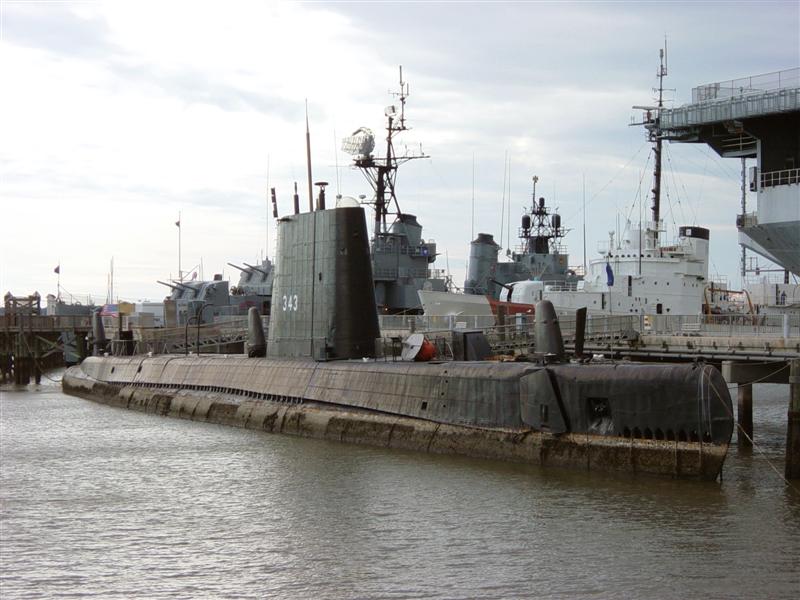
USS Clamagore, GUPPY-III boat prototype
This last conversion started in 1961 and lasted until to 1963, more than fifteen years after the program was initiated. It concerned eight more GUPPY II boats, all upgraded to the new standard. standard. The main difference with the prototype was the addition of a larger, 15-foot (4.6 m) section and that they retained all four diesel engines, for keeping the same performances. They ended therefore with a 322 feet (98 m) long hull overall, and this added 1,975 tons to their displacement. They were also fitted with a modern BQG-4 PUFFS passive ranging sonar. It changed the apearance of the boats by their identifiable by the three “shark fin” sonar domes placed along the topside superstructure. The conning tower in the sail was also longer compared to USS Tiru, gaining an additional 1.5 m section. The reason was to accomodate the new Mk 101 fire control system and an Mk 37 director enabling them to carry and operate the Mark 45 nuclear torpedo. This sail was made entirely in plastic, to spare strategic materials and weight, making them more stable in surface. This program was part of the now global upgrade and life prolongation of WW2 USN assets, the famous Fleet Rehabilitation and Modernization (FRAM) program. It was planned to upgrade all 24 GUPPY II boats but this was curtailed due to budgetary constraints.
In effect, nine were so converted, most exported: USS Clamagore, Cobbler, Corporal (TCG 2. Inönü), Greenfish (Brazilian Amazonas), Tiru, Trumpetfish (Goias), Remora (Katsonis), Volador (Gianfranco Gazzana-Priaroggia), Pickerel (Primo Longobardo).
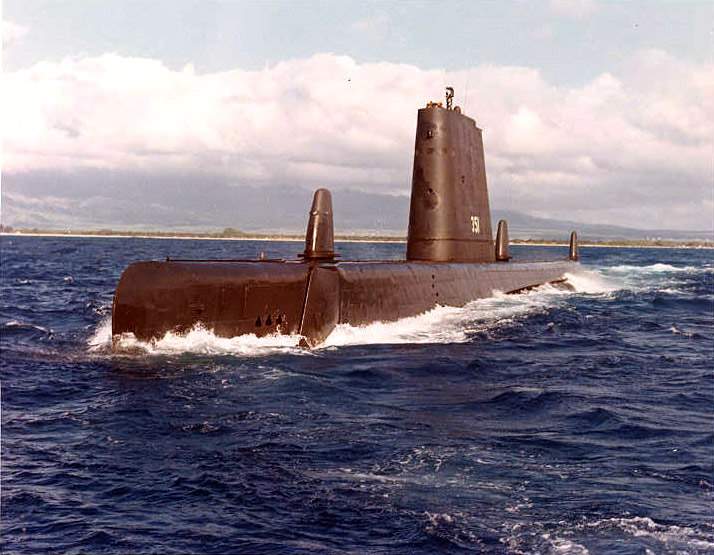
USS Greenfish, a GUPPY-III boat, later sold to Brazil.
Fleet Snorkel Program
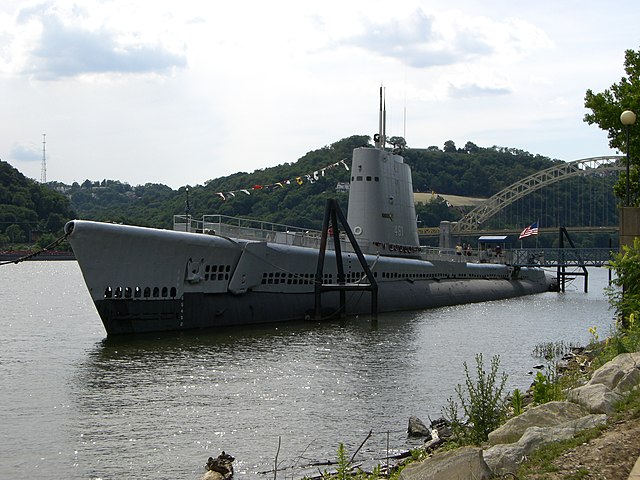

USS Requin, now preserved (SS-481), Fleet Snorkel with the Electric Boat sail.
The Fleet Snorkel boats were WW2 vintage fleet boats fitted with a limited set of upgrades, snorkel induction and exhaust piping, new masts and conning tower. Of course their their deck gun was removed and a modern sonar installed in place of the deck gun magazine. Nothing was done to the propulsion, but the fin was also modernized along the GUPPY Ia standard. Also they had a higher capacity air-conditioning system, and more powerful and upgraded electrical system. Basically it was an austere, cheap upgrade alternative proposal by the bureau of ships to end the upgrade program of all remaining boats on a budget. In 1947 already, the U.S. Navy copied and improved a German snorkel to have their own functional snorkel mast, but too late for the GUPPY I boats (they received it in 1955), on USS Irex (SS 482). They served almost as long as regular GUPPY upgrades, and some were further upgraded during their career: USS Piper, Sea Owl, and Sterlet were fitted with a large BQR-4A bow sonar. USS Chub and Brill were transferred to Turkey in 1948 (TCG Gür, 1. İnönü) and converted as Fleet Snorkel Submarines in 1953, but in a local yard, Gölcük, and completed in the United States.

Fleet Snorkel USS Torsk, now a museum ship, showing the standard transformation. Note the original bow, easier way to recognise them.

Fleet snorkel USS Piper, showing its news bow sonar

Fleet Snorkel USS Requin with a GUPPY III type sail but still the old WW2 vintage hull
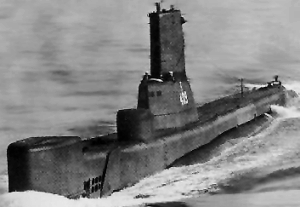 About the snorkel: This contraption was pioneered by the Dutch in the later 1930s and copied by the Germans during the war. It combine and air duct to feed the diesels while underwater, and another to vent out the exhaust fumes. This does not make the subs perfectly invisible, as they still had a thing smoke trail, but this was diesel combustion smoke, barely noticeable. It largely reduced the risk to be spotted and procured some protection against enemy fire, while preserving the batteries. Many applications were found. The snorkel protruding of the war still can be detected by radar though. The Germans started to introduced it in 1944, too late to change the course of the war. However this innovation was not lost to anyone after the war. It became a standard. The USN snorkel connected to the diesels atmosphere through a pair of tubes the air intake, and the exhaust topped by an head-valve on the air-intake mast to water to seep in.
About the snorkel: This contraption was pioneered by the Dutch in the later 1930s and copied by the Germans during the war. It combine and air duct to feed the diesels while underwater, and another to vent out the exhaust fumes. This does not make the subs perfectly invisible, as they still had a thing smoke trail, but this was diesel combustion smoke, barely noticeable. It largely reduced the risk to be spotted and procured some protection against enemy fire, while preserving the batteries. Many applications were found. The snorkel protruding of the war still can be detected by radar though. The Germans started to introduced it in 1944, too late to change the course of the war. However this innovation was not lost to anyone after the war. It became a standard. The USN snorkel connected to the diesels atmosphere through a pair of tubes the air intake, and the exhaust topped by an head-valve on the air-intake mast to water to seep in.
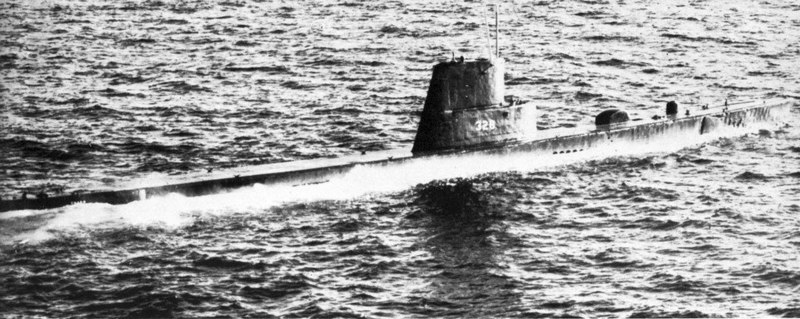
USS Charr (SS 328), fleet snorkel with the Portsmouth sail, circa 1964
In all, 30 boats were converted: USS Sabalo, Sablefish, Bergall (TGC Turgutreis), Besugo (MM Francesco Morosini), Charr, Bugara, Carbonero, Carp, Cusk, Guitarro (TGC Preveze), Kraken (SN Almirante García de los Reyes), Lizardfish (MM Evangelista Torricelli), Mapiro (TGC Pirireis), Mero (TGC Hizirreis), Sterlet, Scabbardfish (HN Traina), Segundo, Sea Cat, Sea Owl, Sennet, Spinax, Piper, Torsk, Argonaut (HMCS Rainbow), Runner, Diablo (PNS Ghazi), Medregal, Requin, Irex, TCG Gür, ex-USS Chub, TCG 1. İnönü ex-USS Brill.
Active service of the Guppies
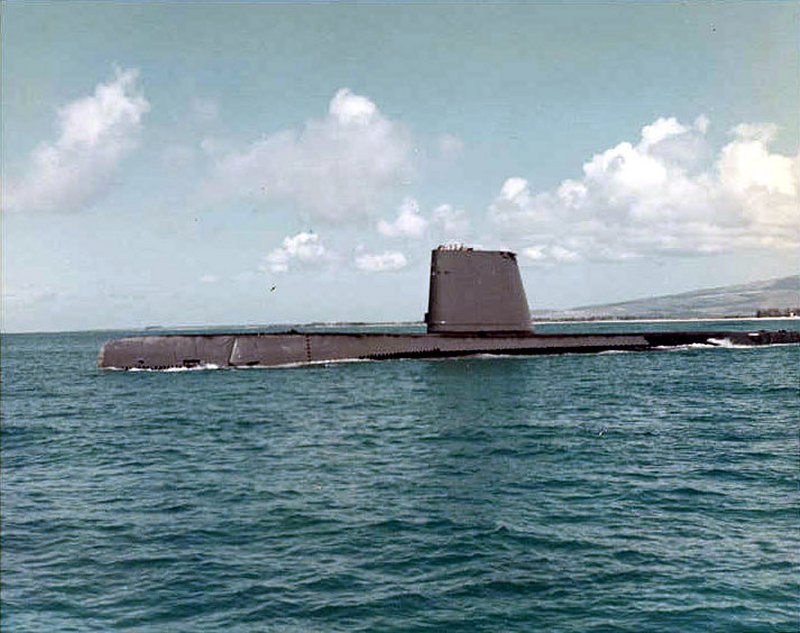
USS Razorback SS-394
The converted to Guppies were in active ad intensive service for most of the cold war, and were “rode hard.” In addition to support ASW training with US and NATO Task Groups, their main task was to run barrier patrols in the infamous GIUK GAP (Between Greenland, Iceland and UK). This narrow passage was the main gate for Soviet submarines to deploy in the Atlantic and threaten the sea lanes. US and allied Navies started a silent watch on this maritime international waters “border” but also monitored all exit points, tracking the deployment of the Soviet Fleet. The Mediterranean was not forgotten either, and for this reason, a healthy number of GUPPies were proposed to allied NATO countries strategic in this area like Turkey, Greece and Italy. Soviet boats of the black sea kept indeed training in the Dardanelles. The British Danish, Dutch, and Norwegian also had their watch tour in the North Sea and Baltic exit points, under supervision by NATO, and some also had these GUPPY models in service, often facilitated by MDAP.
In the Pacific, GUPPies operated from Pearl Harbor and San Diego, but closer to USSR, from Yokosuka as well. They also watched exit points from the North Pacific fleet in Vladivostok. NATO boats also guarded the Kola Peninsula and tracked of operations, tested constantly abilities of all Warsaw Pact Navies. These operations and training exercises became standard deployments at sea, known under several acronyms like ‘WesPac’ (Seventh Fleet Yokosuka, 6-7 months). In ‘MedRun’ boats from New London, Norfolk, Charleston or Key West were attached to the Sixth Fleet also for six months. This meant, these boats had to travel for 15-18 days though the Atlantic gales and Pacific typhoons. UNITAS around South America, could also last for six months. Northern run was the most vital in relation to the GIUK and saw Guppy boats deployed in extremely rough weather, in state 5-8 seas constantly. Atlantic storms and typhoons in the Pacific were not tender either. The Guppy bows were seeing digging deeply and it was soon clear that the stepped sail offered little protection.
It also showed snorkeling was difficult in practice in heavy weather. Around sea state 7-8 it became simply impossible. Snorkel induction was indeed to be kept permanently out of the water in order not to starve the diesels. Constantly doused in water, it was also almost constantly shut automatically. Diesel engines would then run on internal air, and needed some 60,000 cubic feet per minute and per engine. So it took around 10-30 seconds for the engines to draw enough vacuum to shut down automatically, after the snorkel induction head valve shut. It was true whether the boat was running on one or two engines. This occurred at a vacuum of 6-in (150 mm) of mercury below atmosphere like a 6000-foot (1800 m) altitude. Sometimes head valve would shut 5-6 seconds and reopened as the snorkel induction cleared the surface. Atmospheric pressure then would return to normal, until another wave passed. This was an ongoing cycle for days on end.
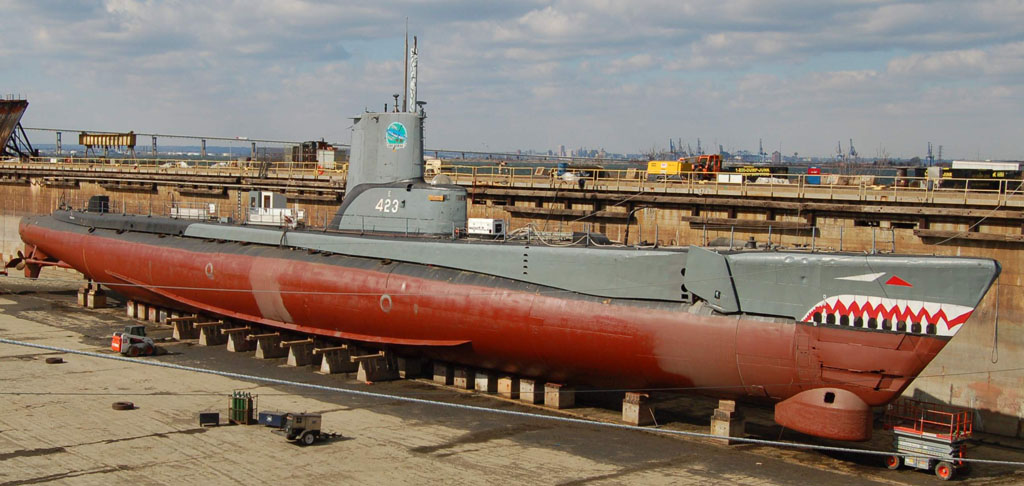
USS Torsk in drydock for maintenance before conversion as a museum ship (credits: Navsource)
Nevertheless, despite these known exercises, the majority of Guppys operations during the Cold War remains classified to this day. But the navy idea to convert this fleet of WW2 veterans or brand new completed subs, was a good one. It cost far less than the newly developed models using late war technology and allowed the USN to still operate a massive submarine fleet and deploy to fill all the missions NATO had. The success of submarine cold war operations therefore, especially in the 1960-70s is a testimony to the Guppy conversions. Both the submarines and their crews “Held the Line” during the Cold War, until nuclear-era SSNs and SSBNs took over the duty. Most of them became museum boats, in this GUPPY style, after a service started some time in 1941 to 1945, so at least thirty years of near-continue service.
Exported Guppies
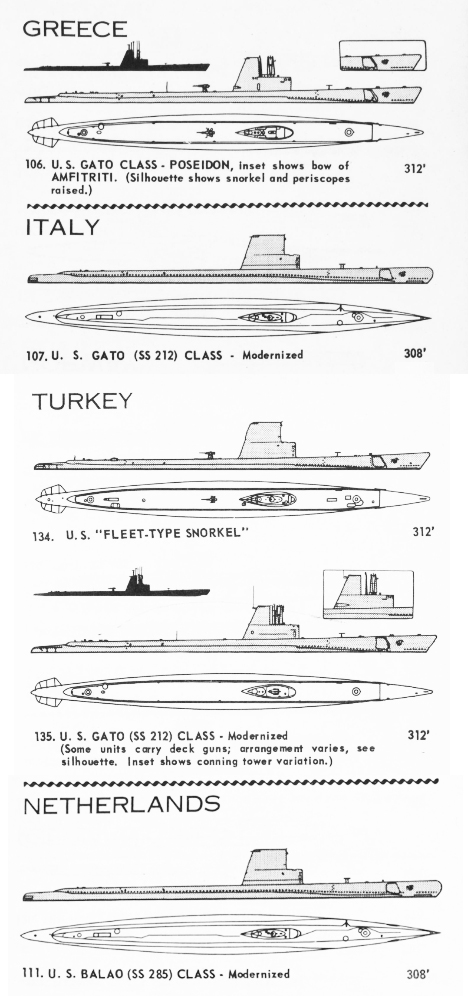
Apart France, Germany and UK, most Europeans obtained via MDAP GUPPY type submarines, sometimes second-hand and already late, in the seventies. Taiwan (ROC Navy) had four time modernized GUPPY III which were still in service until 2020. Amazing for subs which design was dating back from 1938.
Video
Read More/ Src
https://web.archive.org/web/20010409064400/http://guppysubmarinetribute.homestead.com/History.html
https://www.taiwannews.com.tw/en/news/3079227
http://rnsubs.co.uk/articles/development/guppy.html
https://quietwarriors.files.wordpress.com/2014/03/all-hands-nov-1953-midgets-and-baby-subs-join-the-fleet.pdf
http://www.designed4submariners.com/Guppy_I.html
http://www.navsource.org/archives/08/08324.htm
https://laststandonzombieisland.com/tag/malvinas/
https://www.globalsecurity.org/military/systems/ship/guppy.htm
https://americanhistory.si.edu/subs/history/subsbeforenuc/revolution/tiru.html
http://steelnavy.com/BecunaTD.htm
https://totalnavy.com/350guppy.htm
Guppy submarines (book on amazon)
On guppysubmarinetribute
PDF by navsource on the
On Popular Science
Conway’s all the world’s fighting ships 1922-46, 1947-95
Friedman, Norman (1994). U.S. Submarines Since 1945: An Illustrated Design History
Most of what we known came from Jim Christley, which carefully studied declassified documentation and made extensive research on the GUPPY program. Retired from the US Navy in 1982 as a senior chief petty officer, he served on seven submarines or all types and became one of the most looked authors on US submarine technical history. In addition to numerous articles, a book and two fascicules New Vanguard (Osprey publishing) “US Submarines 1941–45”, “US Nuclear Submarines” or “US Submarines 1900–35”.
Model Kits
-Clase Guppy II Santa Fe, Los Huarpes 1:300 GUPPYII
-Walrusklasse/Guppy II Ex USS-367 Icefish Naval Models 1:350
-Balao Class “Guppy” Conversion Tom’s Modelworks 1:350
-Guppy II-class submarine “USS Cutlass” (SS-478) / Taiwan “Sea Lion” AFV Club 1:350
-USS Guppy 1B Class Submarine AFV Club 1:350
-Walrus class Guppy II sub Naval Models 1:350

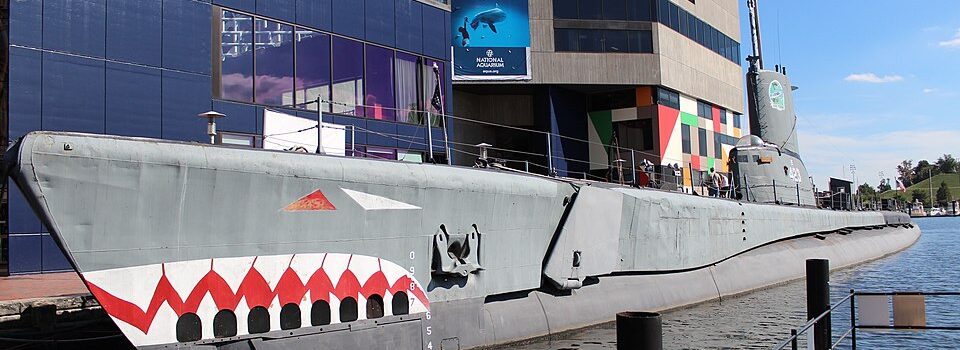


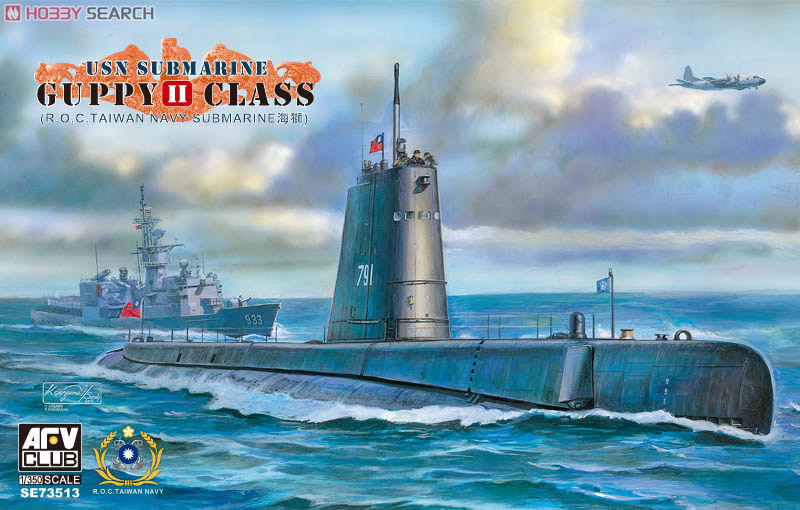
 Latest Facebook Entry -
Latest Facebook Entry -  X(Tweeter) Naval Encyclopedia's deck archive
X(Tweeter) Naval Encyclopedia's deck archive Instagram (@navalencyc)
Instagram (@navalencyc)





 French Navy
French Navy Royal Navy
Royal Navy Russian Navy
Russian Navy Armada Espanola
Armada Espanola Austrian Navy
Austrian Navy K.u.K. Kriegsmarine
K.u.K. Kriegsmarine Dansk Marine
Dansk Marine Nautiko Hellenon
Nautiko Hellenon Koninklije Marine 1870
Koninklije Marine 1870 Marinha do Brasil
Marinha do Brasil Osmanlı Donanması
Osmanlı Donanması Marina Do Peru
Marina Do Peru Marinha do Portugal
Marinha do Portugal Regia Marina 1870
Regia Marina 1870 Nihhon Kaigun 1870
Nihhon Kaigun 1870 Preußische Marine 1870
Preußische Marine 1870 Russkiy Flot 1870
Russkiy Flot 1870 Svenska marinen
Svenska marinen Søværnet
Søværnet Union Navy
Union Navy Confederate Navy
Confederate Navy Armada de Argentina
Armada de Argentina Imperial Chinese Navy
Imperial Chinese Navy Marinha do Portugal
Marinha do Portugal Mexico
Mexico Kaiserliche Marine
Kaiserliche Marine 1898 US Navy
1898 US Navy Sovietskiy Flot
Sovietskiy Flot Royal Canadian Navy
Royal Canadian Navy Royal Australian Navy
Royal Australian Navy RNZN Fleet
RNZN Fleet Chinese Navy 1937
Chinese Navy 1937 Kriegsmarine
Kriegsmarine Chilean Navy
Chilean Navy Danish Navy
Danish Navy Finnish Navy
Finnish Navy Hellenic Navy
Hellenic Navy Polish Navy
Polish Navy Romanian Navy
Romanian Navy Turkish Navy
Turkish Navy Royal Yugoslav Navy
Royal Yugoslav Navy Royal Thai Navy
Royal Thai Navy Minor Navies
Minor Navies Albania
Albania Austria
Austria Belgium
Belgium Columbia
Columbia Costa Rica
Costa Rica Cuba
Cuba Czechoslovakia
Czechoslovakia Dominican Republic
Dominican Republic Haiti
Haiti Hungary
Hungary Honduras
Honduras Estonia
Estonia Iceland
Iceland Eire
Eire Equador
Equador Iran
Iran Iraq
Iraq Latvia
Latvia Liberia
Liberia Lithuania
Lithuania Mandchukuo
Mandchukuo Morocco
Morocco Nicaragua
Nicaragua Persia
Persia San Salvador
San Salvador Sarawak
Sarawak Uruguay
Uruguay Venezuela
Venezuela Zanzibar
Zanzibar Warsaw Pact Navies
Warsaw Pact Navies Bulgaria
Bulgaria Hungary
Hungary

 Bundesmarine
Bundesmarine Dutch Navy
Dutch Navy Hellenic Navy
Hellenic Navy Marina Militare
Marina Militare Yugoslav Navy
Yugoslav Navy Chinese Navy
Chinese Navy Indian Navy
Indian Navy Indonesian Navy
Indonesian Navy JMSDF
JMSDF North Korean Navy
North Korean Navy Pakistani Navy
Pakistani Navy Philippines Navy
Philippines Navy ROKN
ROKN Rep. of Singapore Navy
Rep. of Singapore Navy Taiwanese Navy
Taiwanese Navy IDF Navy
IDF Navy Saudi Navy
Saudi Navy Royal New Zealand Navy
Royal New Zealand Navy Egyptian Navy
Egyptian Navy South African Navy
South African Navy






























 Ukrainian Navy
Ukrainian Navy dbodesign
dbodesign
Thank you very much for your article about the guppiies subarinies. It remainds me a lot of things. I am a retired submariner of the Brazilian Navy. I had the opportunity to be the Engenirring Officer of the Brazilian Submarino “Rio Grande do Sul”, former USS 523 Granpus”. The change of flags cerimony was im 1972,at the USN Submarine Base Grotton.
I would like to have a refreshment on my toughts. Whem the ¨Grampus” was converted to a GUPPY IIA, and this happens a lot of years before the turn over to Brazil, did she had to removed one of the four main diesel engines that she had?
Thank you for tours attention,
Roberto Carvalho.
Hi Roberto, Grampus was an interesting case because she was never completed as a regular Tench boat given her launch date, but served as a prototype GUPPY IIa and my data says she had four diesels indeed Fairbanks-Morse Model 38D8-⅛ linked to her snorkel system. They were reliable so i see no reason why they would have been replaced, plus i can’t find mentions of a downgrade before transfer. If she had worn out diesels at this point i would otherwise understand why she only served for six years under the Brazilian flag. Best,
Dave.
Dear Dave,
Thank you forby your answer. I don”t know why, but I kept in my mind the idea that she had 3 main diesel engines, indeed Fairbanks-Morse.
As I told you I was in Grotton in 1972, as Engeneerig Officer of the “Rio Gannde do Sul”, the Brazilian name of the USS “Grampus”. In 1974 I was back to Grotton, at that time to received as Executive Officer the “Amazonas”, the Brazilian name of the USS “Greenfish”. In the “Amazonas” I stay in the US for almost one year and a half, because she made a ovwehall at the Phipadelphia Navy Shipyard. It was a great experience.
Best regards,
Robero.
Thanks for your feedback Roberto,
All the best !
Roberto, I am hoping you can answer this question. I saw several of the Brazilian navy Guppies in my youth, but never in dry dock. I am going to build a model of one of the Brazilian Guppy IIs, and would like to know if under the waterline they were painted in antifouling red, or were all black. Thank you in advance.
Hi Roberto, not an easy question, let me search this.
I am hoping that the person who asked the previous questions in this thread, who was an officer in these boats, would know the answer to this question. Contact details are not shared (for good reasons) but maybe you could forward my question?
the Dutch DID NOT pioneer the Schnorkel. the Germans did. the only reason the ditch get this misgivings credit is because Germany owned the exact ship builder and yard where the schnorkel was theorized and prototyped.. this very shipyard was also the one that designed the great Typ VII class boats.
this prototyping came AFTER the late WW1 (1917) patenting and trials of a “schnorkel” type device for the Kaiserlich Marine.
so the Schnorkel was never anything but a German design